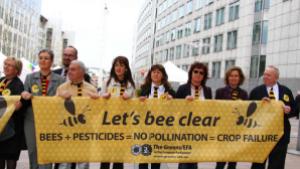Bee-awful: Activist Correlation Studies are not Scientific
Here we go again!
- A second rate correlation study gets published;
- Because it has the words “bees” and “pesticides” in the headline, the newly privatised research institute’s PR machine generates good media pick-up;
- Main media organisations interview the researchers (who seem to find the right apocalyptic vocabulary), but they have not read the study;
- The NGO activists, who might have read some of the news articles, go into campaign overdrive: buzz, buzz, buzz, spin, spin, spin;
- An activist from Friends of the Earth plants an editorial in the Financial Times;
- Green MEPs print up a banner announcing a bee-pocalypse and pose for a picture in Brussels.
Hasn’t anyone in the media learnt the skew of this cynical game yet? Have journalists abandoned responsibility to side with the tawdristic tirades of the activists? Has everyone given up the “investigate, research and then report” practices that I used to teach journalism students (back when there used to be journalism students)? Are journalists now merely opting to take part in campaign activism? I am afraid in a world where a media article’s success is measured according to social media viral lift there is little incentive for journalistic responsibility.
And the activists know this! They march their bull onto their stage and attempt to milk it. In the drama of the thumping about, no one even notices the bloody thing’s got horns. Conclusion: It can’t produce milk anymore and someone is to blame. Print, publish, promote!
Bee-awful: Correlation studies are not scientific
If I go into a poor neighbourhood wanting to confirm my prejudice that immigrants push drugs, I’ll find immigrants and I’ll find drugs. Such a correlation would make me a racist … or, according to the media, a scientist with firm evidence! There is no question of other factors, societal variables or complicating circumstances – the correlation gives what the researcher wants: a simplistic “Yes!”, headlines and a guaranteed publication.
A correlation study starts with a person having a bias, and then defining data parameters to confirm it, moving the bias to a conclusion. It should be used by scientists as a first step in determining whether a study should be conducted (eg, “I’m noticing that a lot of long-term smokers are developing certain cancers; maybe we should look into this”); but now, with the advent of activist science and the media attention garnered by white-coat celebrities like Stephanie Seneff and Dave Goulson, correlation studies have become sufficient to draw apocalyptic conclusions (and glorious reputation-enhancing headlines).
A recent correlation study by researchers mostly from the UK Centre for Ecology and Hydrology (CEH) has drawn such headlines. The CEH started with a prejudice that wild bees are dying in the UK (nobody really knows how many species of wild bees there are in the UK, so apparently you can make that claim), and they attempted to correlate it to the increase in UK production of oilseed rape (and the parallel use of neonicotinoids).
This correlation study had a long list of inherent weaknesses, namely:
- The claim of a wild bee decline was based on data collected by a loose organisation of volunteer enthusiasts who would spot bees and record them during their walks. There was no focus to systematically gather data for a determined study and there was no new research conducted. It was simply random data (although the authors of the study would prefer the euphemism: “not structured”) pushed through some statistical analysis “tool”.
- Wild bee data is quite thin and not robust enough to make any legitimate conclusions (the numbers and number of species in the UK is simply not known). Wild bees became the subject of save-the-bee activist concern after campaigners stopped making the claim that honeybees were affected by neonicotinoids, because, well, data seemed to prove that they weren’t and some activist scientists couldn’t keep ignoring the facts.
- The study did not consider the shifts in agricultural practices over the 18-year survey period that might have had a detrimental effect on biodiversity levels. How farmers rotated their crops was also not brought into the parameters.
- The researchers did not consider the variation from different types of neonicotinoids, the exposure levels of each, the type of dosage … they simply grouped a class of different chemicals as: “neonicotinoids” and did not get deeper into the science.
- In fact, the researchers did not actually consider neonicotinoids, how or when they were applied. They looked at oilseed rape production, assumed it was treated, and then correlated it to the random data from their amateur bee counting enthusiasts. If the farmers had treated OSR fields with the older, less efficient pyrethroid insecticides, many more bees surely would have perished! This was not taken into consideration.
- The researchers seemed, frankly, immature. At one point, the publication went off on a tangent and postulated that similar conclusions could be made for the influence on bees from treated sunflowers, even though they had not studied that and had no data. The key researcher, Dr Nick Isaac, acknowledged in a blog how he had designed the methodology to show how much of the wild bee decline was due to exposure to neonicotinoids. I believe the correct term is “if”. Building bias into the research methodology at the outset is, simply put, activist science.
- A wide range of variables were simply ignored: weather, parasites, viruses, nutrition, other predators, regional urban development … the researchers included nothing that would complicate a clear correlation to prove their hypothesis.
- There were no other hypotheses made to open further scientific debate or add to the body of knowledge. For example, organic farmers have introduced nematodes into their integrated pest management programme to protect against the increase of certain insects, without realising that these nematodes have a taste for wild bee nests and have been hoovering up wintering bumble bees at an alarming rate.
- They did not recognise the limits of a correlation study in the paper. What they presented was assumed as clear, factual conclusions on the state of wild bee health due to neonicotinoids (even putting it down to causal percentages). I could easily perform a correlation study that shows that honeybee populations have increased globally since the introduction of neonicotinoids, or that these bees are thriving in OSR areas not affected by Varroa mites, but I don’t see the point of using a flawed approach for some vain need to prove I’m right!
Scientists should consider other elements and not be driven to drawing prejudiced conclusions on limited and compromised data. In short, the conclusion drawn from the CEH correlation study is at best: mediocre; at worst: shameful. Let me go out on a limb and say this is the worst study on bee health and pesticides that I have ever read: based on random data, bias built into the methodology, no research into the chemical class it aims to condemn, total ignorance of all variables that most scientists acknowledge to be the source of bee decline and no responsibility for the consequences of its contrived conclusions (which were aimed to draw media attention).
What happened next was, well, regrettable. The scientists at the CEH started giving interviewsand writing blogs where they showed their juvenile innocence. Rather than saying that their correlation findings were interesting and needed further study before any responsible conclusions could be drawn, they started making clear conclusions that indicted neonicotinoids. Perhaps the journalists set them up; perhaps the media jumped to conclusions and twisted their statements out of context; perhaps anti-pesticide bias is so built into our agricultural narrative that nobody noticed the claims had no factual bearing.

The media, the NGO activists and the Green politicians have decided to ride this bull for wide range of opportunities:
- it fills a slow August news cycle;
- the CEH and its young researchers have yet to be tainted as an activist science organisation;
- its scientists apparently haven’t received media training yet;
- the EU will be reassessing the data from their neonic ban in January (expect a slew of activist-funded scare studies published in November and December);
- the Brexit result implies the risk that the UK government might actually think about the plight of farmers and regulate rationally.
Bee-mused: How did Friends of the Earth capture the Financial Times?
While this CEH publication was pressed on most mainstream media, the Financial Times spin in the editorial “In defence of bees: a pesticide ban is justified” (FT View, 16 August 2016) was more than simply alarming. It was captured activism we would normally expect from campaign-driven outlets like Le Monde or the Guardian, but not the FT!
The author, assumedly an FT editor as it is uncredited, begins the defence of bees by praising asmall, random bee-counting stunt by Friends of the Earth that identified 370,000 bees in the UK. How is that an impressive or accurate count worth starting the article – about one bee for every citizen in the British town of Bradford?
The article then introduces the CEH study:
“Now new research concludes that neonicotinoids — a group of pesticides chemically similar to the nicotine in tobacco — might have cut the presence of wild bees in the British countryside by up to 30 per cent since they became widely used on oilseed rape crops.”

The CEH study does not actually say neonics are responsible for 30% of the wild bee deaths, and this headline shock factor is not even backed up with a link to the study or reference to it by name. So I guess the FT could say anything they want then!
The editorial then assumes the campaign attack position, declaring how much the global food supply depends on bees, that farmers don’t understand that neonicotinoids don’t work (no reference) and that the big industry players are lobbying hard to silence the critics. My other shoe dropped when I read:
“Policymakers should certainly treat the arguments put forward by pesticide manufacturers — whose tactics are compared by NGOs to those used in the past by tobacco companies — with scepticism.”
The source the FT referenced to justify likening pesticide manufacturers to Big Tobacco was none other than that same friendly bunch that counted all of those bees: Friends of the Earth (who published a rabid report in 2014 of loose innuendo on industry lobbying that was largely ignored and quickly forgotten … except, obviously, by the editor of the Financial Times!!!). At this point, does anyone not get that this article was ghost-written by Friends of the Earth?
The article concludes that the EU ban against neonicotinoids not only must be renewed in 2017, but made stronger, because, after all: “There are other ways to manage pests that deserve attention.” And that is the FT’s ‘defence of bees’!
This has to be, in my living memory, the worst example of activist capture of a main news organisation, and of all places, at the Financial Times. How did Friends of the Earth worm their way onto the FT’s editorial desk? Was the editor on holiday after inadvertently leaving the access codes on the Tube? Shouldn’t the author of this article, if he or she had followed FT standards, at least have read the CEH report (or perhaps bothered to do a Google search to provide a direct link)! There was no critical analysis like the basic points drawn above. Instead, the FT editor chose to use the publication to make policy demands that are simplistic, harmful for agriculture and likely more detrimental to bee health when alternatives are considered.
While the Friends of the Earth lobbyists must be proud of their ability to plant this story in the FT, I suspect that its readers must be questioning such poor journalism and activist bias. This is some seriously sour bull-milk!
Read more at risk-monger.com
Trackback from your site.
